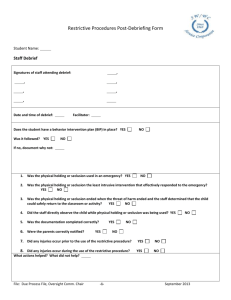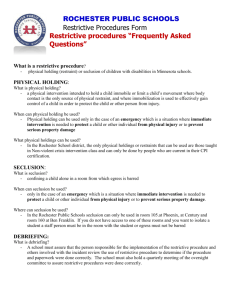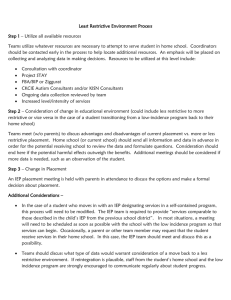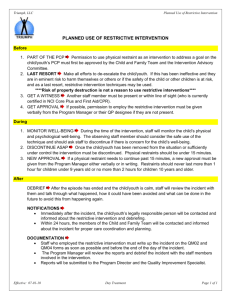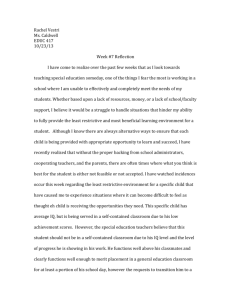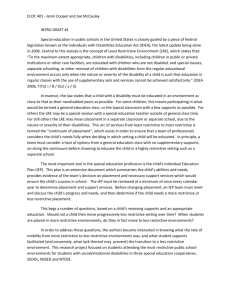Date of plan: August 2011 Revised: December 2014 The Use of
advertisement
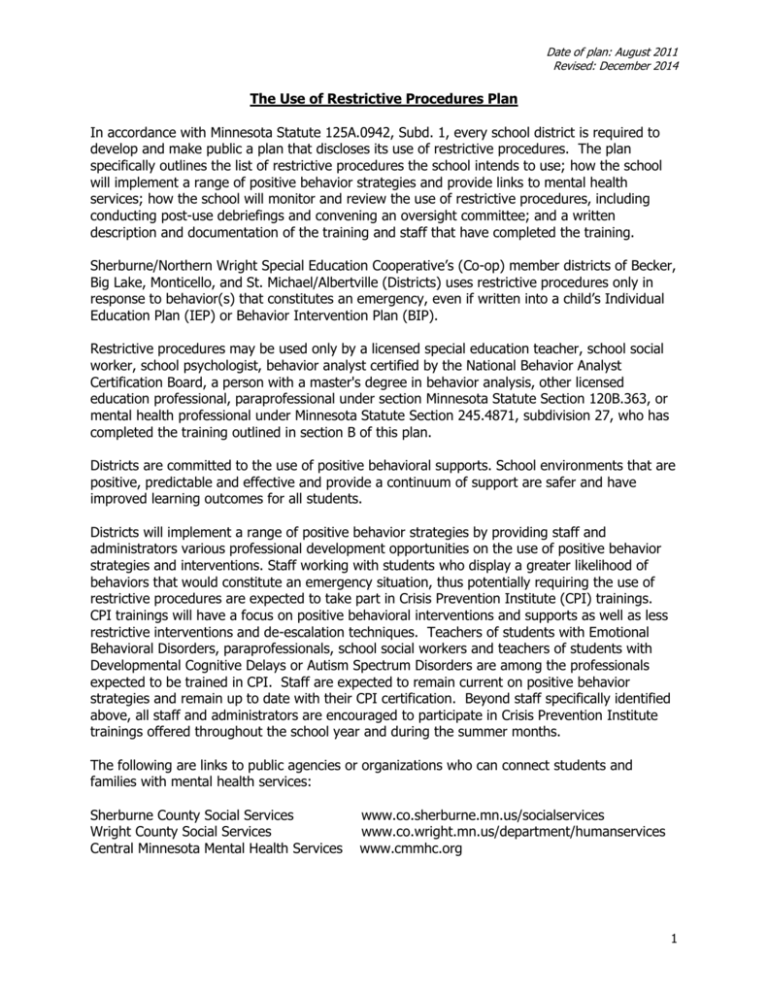
Date of plan: August 2011 Revised: December 2014 The Use of Restrictive Procedures Plan In accordance with Minnesota Statute 125A.0942, Subd. 1, every school district is required to develop and make public a plan that discloses its use of restrictive procedures. The plan specifically outlines the list of restrictive procedures the school intends to use; how the school will implement a range of positive behavior strategies and provide links to mental health services; how the school will monitor and review the use of restrictive procedures, including conducting post-use debriefings and convening an oversight committee; and a written description and documentation of the training and staff that have completed the training. Sherburne/Northern Wright Special Education Cooperative’s (Co-op) member districts of Becker, Big Lake, Monticello, and St. Michael/Albertville (Districts) uses restrictive procedures only in response to behavior(s) that constitutes an emergency, even if written into a child’s Individual Education Plan (IEP) or Behavior Intervention Plan (BIP). Restrictive procedures may be used only by a licensed special education teacher, school social worker, school psychologist, behavior analyst certified by the National Behavior Analyst Certification Board, a person with a master's degree in behavior analysis, other licensed education professional, paraprofessional under section Minnesota Statute Section 120B.363, or mental health professional under Minnesota Statute Section 245.4871, subdivision 27, who has completed the training outlined in section B of this plan. Districts are committed to the use of positive behavioral supports. School environments that are positive, predictable and effective and provide a continuum of support are safer and have improved learning outcomes for all students. Districts will implement a range of positive behavior strategies by providing staff and administrators various professional development opportunities on the use of positive behavior strategies and interventions. Staff working with students who display a greater likelihood of behaviors that would constitute an emergency situation, thus potentially requiring the use of restrictive procedures are expected to take part in Crisis Prevention Institute (CPI) trainings. CPI trainings will have a focus on positive behavioral interventions and supports as well as less restrictive interventions and de-escalation techniques. Teachers of students with Emotional Behavioral Disorders, paraprofessionals, school social workers and teachers of students with Developmental Cognitive Delays or Autism Spectrum Disorders are among the professionals expected to be trained in CPI. Staff are expected to remain current on positive behavior strategies and remain up to date with their CPI certification. Beyond staff specifically identified above, all staff and administrators are encouraged to participate in Crisis Prevention Institute trainings offered throughout the school year and during the summer months. The following are links to public agencies or organizations who can connect students and families with mental health services: Sherburne County Social Services Wright County Social Services Central Minnesota Mental Health Services www.co.sherburne.mn.us/socialservices www.co.wright.mn.us/department/humanservices www.cmmhc.org 1 Date of plan: August 2011 Revised: December 2014 A. Definitions from Minnesota Statute 125A.0941 The following terms are defined as: 1. "Emergency" means a situation where immediate intervention is needed to protect a child or other individual from physical injury. Emergency does not mean circumstances such as: a child who does not respond to a task or request and instead places his or her head on a desk or hides under a desk or table; a child who does not respond to a staff person's request unless failing to respond would result in physical injury to the child or other individual; or an emergency incident has already occurred and no threat of physical injury currently exists. 2. "Physical holding" means physical intervention intended to hold a child immobile or limit a child's movement, where body contact is the only source of physical restraint, and where immobilization is used to effectively gain control of a child in order to protect a child or other individual from physical injury. The term physical holding does not mean physical contact that: (1) helps a child respond or complete a task; (2) assists a child without restricting the child's movement; (3) is needed to administer an authorized health-related service or procedure; or (4) is needed to physically escort a child when the child does not resist or the child's resistance is minimal. 3. “Positive behavioral interventions and supports” means interventions and strategies to improve the school environment and teach children the skills to behave appropriately. 4. "Prone restraint" means placing a child in a face down position. 5. “Restrictive procedures” means the use of physical holding or seclusion in an emergency. Restrictive procedures must not be used to punish or otherwise discipline a child. 6. "Seclusion" means confining a child alone in a room from which egress is barred. Egress may be barred by an adult locking or closing the door in the room or preventing the child from leaving the room. Removing a child from an activity to a location where the child cannot participate in or observe the activity is not seclusion. B. Staff Training - Requirements and Activities Requirements Staff who design and use behavioral interventions will complete training in the use of positive approaches as well as restrictive procedures. This may include, but is not limited to school psychologists, teachers of students with Emotional Behavioral Disorders, paraprofessionals, school social workers and teachers of students with Developmental Cognitive Delays and/or Autism. Training records will identify the content of the training, 2 Date of plan: August 2011 Revised: December 2014 attendees and training dates. The Co-op will compile a list of all Crisis Prevention Institute (CPI) trainings which will remain on file in the coop offices. The district will maintain records of additional trainings provided within the district. Initial Crisis Prevention Institute Trainings will be offered at least four times per year. Refresher Crisis Prevention Institute Trainings will be offered at least eight times per year. Staff who may be involved in implementing a prone restraint, must complete Professional Crisis Management (PCM) training prior to implementing a prone restraint. Parents of students for whom prone restraints may be used will be encouraged and supported to attend PCM training as well. Training records will identify the content of the training, attendees and training dates. The Co-op will compile a list of all Professional Crisis Management (PCM) trainings. The district will maintain records of additional trainings provided within the district. Activities Professional development activities will be provided to district staff and contracted personnel who have routine contact with students and who may use restrictive procedures in the following areas: 1. Positive behavioral interventions; 2. Communicative intent of behaviors; 3. Relationship building; 4. Alternatives to restrictive procedures, including techniques to identify events and environmental factors that may escalate behavior; 5. De-escalation methods; 6. Standards for using restrictive procedures only in an emergency 7. Obtaining emergency medical assistance; 8. Physiological and psychological impact of physical holding and seclusion; 9. Monitoring and responding to a child’s physical signs of distress when physical holding is being used; 10. Recognizing the symptoms of and interventions that may cause positional asphyxia when physical holding is used. 11. District policies and procedures for timely reporting an documenting each incident involving use of a restricted procedure; and 12. School-wide programs on positive behavior strategies. C. Physical Holding, Seclusion, and Prohibited Procedures Physical Holding Physical holding as defined above, may only be used in an emergency as defined above. A school that uses physical holding shall meet the following requirements: (1) it is the least intrusive intervention that effectively responds to the emergency; (2) physical holding is not used to discipline a noncompliant child; (3) physical holding ends when the threat of harm ends and the staff determines the child can safely return to the classroom or activity; 3 Date of plan: August 2011 Revised: December 2014 (4) staff directly observes the child while physical holding is being used; (5) each time physical holding is used, the staff person who implements or oversees the physical holding documents, as soon as possible after the incident concludes, the following information: (i) a description of the incident that led to the physical holding; (ii) why a less restrictive measure failed or was determined by staff to be inappropriate or impractical; (iii) the time the physical holding began and the time the child was released; and (iv) a brief record of the child's behavioral and physical status Until August 1, 2015, a school district may use prone restraints with children age five or older if: (1) the district has provided to the department a list of staff who have had specific training on the use of prone restraints; (2) the district provides information on the type of training that was provided and by whom; (3) only staff who received specific training use prone restraints; (4) each incident of the use of prone restraints is reported to the department within five working days on a form provided by the department; and (5) the district, before using prone restraints, must review any known medical or psychological limitations that contraindicate the use of prone restraints. The District may use the following types of physical holding: Children’s Control, Team Control, Team Escort, Interim Control, Reverse Escort, Seated Children’s Control, Emergency Floor Restraint, Prone Restraint or any additional physical holds specifically used in CPI or PCM trainings. Seclusion Seclusion as defined above, may only be used in an emergency as defined above. A school that uses physical holding shall meet the following requirements: (1) it is the least intrusive intervention that effectively responds to the emergency; (2) seclusion is not used to discipline a noncompliant child; (3) seclusion ends when the threat of harm ends and the staff determines the child can safely return to the classroom or activity; 4 Date of plan: August 2011 Revised: December 2014 (4) staff directly observes the child while seclusion is being used; (5) each time seclusion is used, the staff person who implements or oversees the seclusion documents, as soon as possible after the incident concludes, the following information: (i) a description of the incident that led to the seclusion; (ii) why a less restrictive measure failed or was determined by staff to be inappropriate or impractical; (iii) the time the seclusion began and the time the child was released; and (iv) a brief record of the child's behavioral and physical status (6) the room used for seclusion must: (i) be at least six feet by five feet; (ii) be well lit, well ventilated, adequately heated, and clean; (iii) have a window that allows staff to directly observe a child in seclusion; (iv) have tamperproof fixtures, electrical switches located immediately outside the door, and secure ceilings; (v) have doors that open out and are unlocked, locked with keyless locks that have immediate release mechanisms, or locked with locks that have immediate release mechanisms connected with a fire and emergency system; and (vi) not contain objects that a child may use to injure the child or others; (7) before using a room for seclusion, a school must: (i) receive written notice from local authorities that the room and the locking mechanisms comply with applicable building, fire, and safety codes; and (ii) register the room with the commissioner, who may view that room Prohibited Procedures The following actions or procedures are considered prohibited by Minnesota Statute. Prohibited actions or procedures will not be used on student (1) engaging in conduct prohibited under Minnesota Statute 121A.58; (2) requiring a child to assume and maintain a specified physical position, activity, or posture that induces physical pain; (3) totally or partially restricting a child's senses as punishment; (4) presenting an intense sound, light, or other sensory stimuli using smell, taste, substance, or spray as punishment; 5 Date of plan: August 2011 Revised: December 2014 (5) denying or restricting a child's access to equipment and devices such as walkers, wheelchairs, hearing aids, and communication boards that facilitate the child's functioning, except when temporarily removing the equipment or device is needed to prevent injury to the child or others or serious damage to the equipment or device, in which case the equipment or device shall be returned to the child as soon as possible; (6) interacting with a child in a manner that constitutes sexual abuse, neglect, or physical abuse under Minnesota Statute 626.556; (7) withholding regularly scheduled meals or water; (8) denying access to bathroom facilities; and (9) physical holding that restricts or impairs a child's ability to breathe, restricts or impairs a child's ability to communicate distress, places pressure or weight on a child's head, throat, neck, chest, lungs, sternum, diaphragm, back, or abdomen, or results in straddling a child's torso. Nothing in this section precludes the use of reasonable force under Minnesota Statutes 121A.582; 609.06 subdivision 1; and 609.379 D. Monitoring the Use of Restrictive Procedures District Special Education Coordinators will monitor the use of restrictive procedures through their direct and frequent contact with service providers. Service providers are expected to document the use of restrictive procedures and submit this documentation to coordinators within 24 hours of completion. Districts will make reasonable efforts to notify the parent on the same day a restrictive procedure is used on the child, or if the school is unable to provide same-day notice, notice will be sent within two days by written or electronic means or as otherwise indicated by the child’s parent. Post-use debriefing meetings will held to review the required documentation: (1) a description of the incident that led to the physical holding or seclusion; (2) why a less restrictive measure failed or was determined by staff to be inappropriate or impractical; (3) the time the physical holding or seclusion began and the time the child was released; and (4) a brief record of the child's behavioral and physical status The district must hold an individualized education program (IEP) team meeting within ten calendar days after district staff use restrictive procedures on two separate school days within 30 calendar days or a pattern of use emerges and the child's IEP or behavior intervention plan 6 Date of plan: August 2011 Revised: December 2014 does not provide for using restrictive procedures in an emergency; or at the request of a parent or the district after restrictive procedures are used. The IEP team will conduct or review a functional behavioral analysis, review data, consider developing additional or revised positive behavioral interventions and supports, consider actions to reduce the use of restrictive procedures, and modify the IEP or behavior intervention plan as appropriate. The district must review use of restrictive procedures at a child's annual IEP meeting when the child's IEP provides for using restrictive procedures in an emergency. If the IEP team determines that existing interventions and supports are ineffective in reducing the use of restrictive procedures or the district uses restrictive procedures on a child on ten or more school days during the same school year, the team, as appropriate, either must consult with other professionals working with the child; consult with experts in behavior analysis, mental health, communication, or autism; consult with culturally competent professionals; review existing evaluations, resources, and successful strategies; or consider whether to reevaluate the child. At the individualized education program IEP meeting the team must review any known medical or psychological limitations, including any medical information the parent provides voluntarily, that contraindicate the use of a restrictive procedure, consider whether to prohibit that restrictive procedure, and document any prohibition in the individualized education program or behavior intervention plan. An IEP team may plan for using restrictive procedures and may include these procedures in a child's IEP or behavior intervention plan; however, the restrictive procedures may be used only in response to behavior that constitutes an emergency, consistent with the definition above. The IEP or behavior intervention plan shall indicate how the parent wants to be notified when a restrictive procedure is used. E. District Oversight Committee Each member District shall convene an oversight committee to undertake a quarterly review of the use of restrictive procedures based on patterns or problems indicated by similarities in the time of day, day of the week, duration of the use of a procedure, the individuals involved, or other factors associated with the use of restrictive procedures; the number of times a restrictive procedure is used school-wide and for individual children; the number and types of injuries, if any, resulting from the use of restrictive procedures; whether restrictive procedures are used in nonemergency situations; the need for additional staff training; and proposed actions to minimize the use of restrictive procedures; Each member District shall publically identify oversight committee members who must at least include: (1) a mental health professional, school psychologist, or school social worker; 7 Date of plan: August 2011 Revised: December 2014 (2) an expert in positive behavior strategies; (3) a special education administrator; and (4) a general education administrator. Oversight committee members are listed by district. Becker School District 1. Jennifer Weisenberger, School Psychologist 2. Mark Graham, Behavior Intervention Specialist 3. Amy Green, Assistant Director of Special Education 4. Christine Glomski, Becker Intermediate Elementary School Principal Big Lake School District 1. Sara Fidler, School Psychologist 2. Becky King, School Psychologist 3. Amy Green, Assistant Director of Special Education 4. Andrew Sawatzke, Independence Elementary Assistant Principal Monticello School District 1. Nathan Rowe, School Psychologist 2. Jeff Meierhofer, School Psychologist 3. Amy Green, Assistant Director of Special Education 4. Gabe Hackett, Little Mountain Elementary School Principal St. 1. 2. 3. 4. Michael-Albertville School District Dawn Vo, School Psychologist Laura Seifert-Hertling, Special Education Coordinator Amy Green, Assistant Director of Special Education Jenny Kelly, St. Michael-Albertville Middle School East Principal 8
